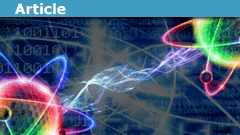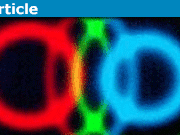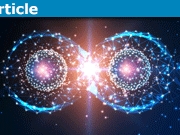Can You Measure Quantum Entanglement?
Though any pair of particles, given their history, might happen to be entangled, some pairs are more entangled than others.
Since at least the 1990s, physicists have been honing their understanding and treatment of quantum entanglement. In the past few decades, entanglement has been used as a resource in groundbreaking new techniques giving rise to quantum cryptography, quantum superdense coding, quantum teleportation, and even quantum computing.
However, just as a better understanding of entanglement has given rise to these feats of quantum engineering, these new techniques have also informed our understanding of quantum entanglement.
With this in mind, it is crucial to understand just what we are measuring when we say we’re measuring entanglement. Indeed, quantum entanglement is one of those scientific buzzwords that sounds terribly impressive, but what is it, really?
The distinction between whether or not a pair of particles (i.e., the state describing them) is entangled at all is surprisingly straightforward and makes for a good starting point.
Let’s assume we have a pair of independent particles A and B. Independent particles can each be described by their own independent quantum wavefunctions—one for A and another for B. If these particles are isolated from any external disturbances, and they do not interact with each other, then at all times they will remain independent; the state describing the pair AB, [itex]\psi(x_A,x_B)[/itex], will always factor into a product of states [itex]\psi_A (x_A)\psi_B (x_B)[/itex] for A and B, respectively.
However, if the pair of isolated particles do interact with each other, say, (like a pair of isolated electrons repelling each other), then the wavefunction describing the pair AB over time might no longer factor into a product (one for A and another for B). When the joint wavefunction is non-separable like this, we say (i.e., define) that it is “entangled”. Based on this idea, we can make very general definitions of what makes for a separable state, and from that what an entangled state is supposed to be.
So, a state is entangled if it is not separable, and a separable state is one that could’ve come from independent pairs of particles. What does this have to do with measuring entanglement?
There are actually (at least) two schools of thought on what one’s measuring when measuring entanglement. On the one hand, entanglement is a resource consumed in the techniques mentioned above; The more entanglement a pair of particles has, the better they can be used to, say convey more information in super-dense coding. Indeed, different measures of entanglement are defined based on these different techniques. On the other hand, entanglement is thought of as a property of the quantum state itself, a geometric property. There are other measures of entanglement based on this idea such as, say, the “distance” to the nearest separable state, but they all agree on the same set of assumptions defining them.
A measure of entanglement must:
- Be zero (i.e., a minimum) for separable states
- Be non increasing under local operations ( since you can’t make more entanglement without more interaction)
- Be a continuous function of the quantum state (since an infinitesimally different quantum state ought to have at most an infinitesimally different amount of entanglement).
There’s still a fair amount of debate over what other axioms might uniquely define a measure of entanglement. The measures we do have are many, and each has its own uses. With new results, we may find that the many different measures of entanglement actually capture different aspects of the same quality. Research is still ongoing.





[QUOTE="gill1109, post: 5214568, member: 401042"]What about entanglement swapping? https://vcq.quantum.at/fileadmin/Publications/1993-06.pdfWe can get particles entangled with one another, which never ever interacted with one another in the past…[/QUOTE]Entanglement swapping requires interaction between the particles. (Not directly, but there's a clear path of effects linking one to the other.)To recap the entanglement swapping process:
If you don't do conditionally apply X and Z rotations to B1 or A1, then Alice and Bob won't know what kind of entanglement is present (agreeing values vs opposite values, same phase vs opposite phase) and the various cases will average into observationally-not-entangled.The path of effects from A1 to B1 is:
[QUOTE="georgir, post: 5214643, member: 258599"][/QUOTE]So what about http://arxiv.org/abs/1508.05949 Experimental loophole-free violation of a Bell inequality using entangled electron spins separated by 1.3 km Hensen et al. Of course we should maybe wait for peer review…
[QUOTE="gill1109, post: 5214568, member: 401042"]What about entanglement swapping? https://vcq.quantum.at/fileadmin/Publications/1993-06.pdfWe can get particles entangled with one another, which never ever interacted with one another in the past…[/QUOTE][QUOTE]If these particles are isolated from any external disturbances, and they do not interact with each other, then at all times they will remain independent;[/QUOTE]
This is all way over my head, but anyway – for those wanting mentions of an actual measure:https://en.wikipedia.org/wiki/Von_Neumann_entropy(Strangely, that article itself does not clearly call it a measure for entanglement, but it is referenced as such from i.e. https://en.wikipedia.org/wiki/Bell_state)
[QUOTE="Finny, post: 5171508, member: 557320"]From the insights post:"However, if the pair of isolated particles do interact with each other, say, (like a pair of isolated electrons repelling each other)…""What does 'interact' mean?When do charged particles not interact?[/QUOTE]In fairness, charged particles always interact. Charged particles generate electromagnetic fields, which push and pull other charges. However, there are other circumstances in which other particles will interact depending on the medium they exist in. An example of this is the quantum-optical process known as four-wave mixing, where two photons enter a nonlinear medium such as rubidium gas, interact while in that medium, and exit out the other side of the vapor cell.
[QUOTE="Finny, post: 5171508, member: 557320"]When do charged particles not interact?[/QUOTE]It's probably fair to say that they always interact, but the interaction could be weak or strong. Maybe we could say that the degree of entanglement is related to the sense that the perturbation due to the interaction (e.g. electrostatic force) is large or small compared with the observable's spread due to the uncertainty. If the mutual force nudges particle A to the right, then particle B will veer to the left – hence correlation, aka engtanglement. If the nudging/veering is noticeable against the quantum "noise" then we have entanglement.
From the insights post:"However, if the pair of isolated particles do interact with each other, say, (like a pair of isolated electrons repelling each other)…""What does 'interact' mean? When do charged particles not interact?
[QUOTE="atyy, post: 5169894, member: 123698"]In a different thread, Haelfix and I were discussing notions of locality. We both agreed that quantum mechanics is consistent with locality defined as "no faster than light communication". However, I think he was trying to make a point that there is another sense of locality. In this post https://www.physicsforums.com/threads/is-the-cat-alive-dead-both-or-unknown.819497/page-8#post-5151673, Haelfix writes:"So how about this. Take the usual EPR setup with system A and B prepared in a maximally entangled pure state and allow another system C to be nearby. Take B off to Alpha Centauri and after some time make a measurement on every box and write down the results. We have now broken the entanglement between A and B, and can allow those systems to develop new entanglements, by say allowing them to interact with the environment.Now at some fixed and agreed upon later time after those initial measurements but before the light travel time between Earth and Alpha Centauri, make a measurement on box B and C. Write the results down, and have your partner fly back to compare notes.Here is the important thing. There will never be a correlation between the results in box B and C. Repeat the experiment however many times you want, you will always find the same result. The conclusion is obvious. B/c A and B were in a maximally entangled state, by monogamy of entanglement they could not be entangled with C. Further, once C was spacelike seperated, it could never create entanglement with B, even after the original entanglement was broken. This is a physical statement about the locality of the laws of physics and is not just about the transfer of information."Is that right? It wasn't clear to me. On the one hand, local operations and classical communication cannot change entanglement. On the other hand, how about identical particles. In some sense, it seems they are entangled, no matter how far away they are.[/QUOTE]Is monogamy of entanglement all or nothing?Is there a theoretical limit to the many body entanglement system size, over spacetime? It always sounds like the line where decoherence stops, or cancels all entanglement effects and "entanglement witnesses violations", must be drawn somewhere so we can explain why the world we experience is not QM. This still eludes me. How do we know there are no QM efects manifest at classical scales? I mean why wouldn't there be? (I'm not talking new age twaddle)How does the SLOT fit with the process of entanglement and decoherence. Have you seen the recent Smolin Paper on "maximal variety"? I wish I could see where the SLOT relates to it. Smolin only wants to experiment with electrons. I'm still interested in a system like Saturn's rings. Do we know for sure a system like that is not an entanglement witness violation? Seems like it is a question that could potentially be asked carefully. How chaotic is it, how chaotic should it be, by when, based on all non-QM processes? Or can we only know "it's chaotic"? Is their any way at all to ask about a measure of entanglement in its structural history?
that being said, I expect the method I stated would work as well. It's not the basis of entanglement swapping/teleportation, though.Let's say C and D are a pair of particles entangled in position-momentum. C hurtles toward A and D hurtles toward B.Let A and B be spacelike separated from each other, and be approximately at rest (though it is impossible to be exactly so)When A collides with C, and D collides with B, the momentum correlations between C and D will be transferred to A and B.At the instant just after the collision, the positions of A and B will be highly correlated (since we placed them nearly at rest relative to each other). Also the momenta of A and B will be highly anti-correlated.In this case we could demonstrate that A and B are entangled through a demonstration of the EPR paradox.
[QUOTE="Jimster41, post: 5169854, member: 517770"]I thought I understood this one the first time I read it but now, I realize I missed something… How do A and B become entangled?[/QUOTE]Well, I made a mistake, that's how!The way it would really work is this:A and C are spacelike separated and unentangled with each otherB is entangled with A, and D is entangled with Cby measuring the pair BD in a basis of entangled joint states, the state of A and D will become entangled as a resultIt is that that's the basis of entanglement swapping, and quantum teleportation.Mea culpa
In a different thread, Haelfix and I were discussing notions of locality. We both agreed that quantum mechanics is consistent with locality defined as "no faster than light communication". However, I think he was trying to make a point that there is another sense of locality. In this post https://www.physicsforums.com/threads/is-the-cat-alive-dead-both-or-unknown.819497/page-8#post-5151673, Haelfix writes:"So how about this. Take the usual EPR setup with system A and B prepared in a maximally entangled pure state and allow another system C to be nearby. Take B off to Alpha Centauri and after some time make a measurement on every box and write down the results. We have now broken the entanglement between A and B, and can allow those systems to develop new entanglements, by say allowing them to interact with the environment.Now at some fixed and agreed upon later time after those initial measurements but before the light travel time between Earth and Alpha Centauri, make a measurement on box B and C. Write the results down, and have your partner fly back to compare notes.Here is the important thing. There will never be a correlation between the results in box B and C. Repeat the experiment however many times you want, you will always find the same result. The conclusion is obvious. B/c A and B were in a maximally entangled state, by monogamy of entanglement they could not be entangled with C. Further, once C was spacelike seperated, it could never create entanglement with B, even after the original entanglement was broken. This is a physical statement about the locality of the laws of physics and is not just about the transfer of information."Is that right? It wasn't clear to me. On the one hand, local operations and classical communication cannot change entanglement. On the other hand, how about identical particles. In some sense, it seems they are entangled, no matter how far away they are.
[QUOTE="jfizzix, post: 5169764, member: 190322"]Let's add one more particle D into the mix…If A and C are unentangled and spacelike separated..and A locally interacts with Band C locally interacts with Dand particles C and D are entangled with each other,then particles A and B can become entangled with each other even though they are spacelike separated.This is the basis for quantum teleportation and entanglement swapping.[/QUOTE]I thought I understood this one the first time I read it but now, I realize I missed something… How do A and B become entangled?
[QUOTE="ZapperZ, post: 5169693, member: 6230"]I actually got mislead by the title of the article in a different way. When I read something that says "Measuring Quantum Entanglement", I was expecting description of actual experiments and how the measured quantities on how they are correlated via such entanglement.[/QUOTE]Measuring the amount of entanglement in a pair of quantum particles currently requires knowing the complete joint quantum state describing the pair. Figuring out the joint quantum state can be done experimentally with a variety of methods, though it gets rather difficult for large-dimensional systems.The amount of entanglement would then be calculated from the state obtained.However, simply witnessing that a pair of quantum particles is entangled can be done more directly in an experiment by violating an entanglement witness.An entanglement witness is an inequality that all separable quantum states satisfy, so that all states violating such an inequality are necessarily entangled.Examples of such inequalities are Bell inequalities, and EPR-steering inequalities (i.e., demonstrations of the EPR paradox).
[QUOTE="atyy, post: 5169673, member: 123698"]So if there are two spacelike particles A and C that are initially not entangled, can they become entangled via local interactions (say the Hamiltonian obeys cluster decomposition), say if A interacts with B and B interacts with C, where B is not spacelike separated from A nor spacelike separated from C?[/QUOTE]Let's add one more particle D into the mix…If A and C are unentangled and spacelike separated..and A locally interacts with Band C locally interacts with Dand particles C and D are entangled with each other,then particles A and B can become entangled with each other even though they are spacelike separated.This is the basis for quantum teleportation and entanglement swapping.
[QUOTE="Strilanc, post: 5168881, member: 96470"]Seems correct. A bit odd not to mention any of the actual measures, though.[/QUOTE]I actually got mislead by the title of the article in a different way. When I read something that says "Measuring Quantum Entanglement", I was expecting description of actual experiments and how the measured quantities on how they are correlated via such entanglement.Zz.
[QUOTE="jfizzix, post: 5169640, member: 190322"]If a pair of isolated particles cannot interact with each other, they will remain unentangled in the past, present, and future.However, if a pair of particles do interact, all we can be sure of is that it's possible for them to become entangled. Depending on the interaction, they may become entangled in different ways, and indeed, might become unentangled again later on.The interaction serves as a means for the joint wavefunction to evolve in a way that is not reducible to wavefunctions of individual particles. Particles may become entangled and disentangled again by this interaction.[/QUOTE]So if there are two spacelike particles A and C that are initially not entangled, can they become entangled via local interactions (say the Hamiltonian obeys cluster decomposition), say if A interacts with B and B interacts with C, where B is not spacelike separated from A nor spacelike separated from C?
[QUOTE="Jimster41, post: 5169499, member: 517770"]while reading I sort of jumped to… "The degree to which a pair of particles have shared history" as either a measure or cause of entanglement. Not sure where I got that (misinterpreting Susskind probably). Is there any sense in which that is right?If so is there any sense in which the degree to which particles have shared future, is meaningful?[/QUOTE]If a pair of isolated particles cannot interact with each other, they will remain unentangled in the past, present, and future.However, if a pair of particles do interact, all we can be sure of is that it's possible for them to become entangled. Depending on the interaction, they may become entangled in different ways, and indeed, might become unentangled again later on.The interaction serves as a means for the joint wavefunction to evolve in a way that is not reducible to wavefunctions of individual particles. Particles may become entangled and disentangled again by this interaction.
while reading I sort of jumped to… "The degree to which a pair of particles have shared history" as either a measure or cause of entanglement. Not sure where I got that (misinterpreting Susskind probably). Is there any sense in which that is right? If so is there any sense in which the degree to which particles have shared future, is meaningful?
Thanks for the insight article!
I considered mentioning the Entanglement of Formation: -(the percentage of Bell states needed on average to synthesize copies of the quantum state in question).I also considered mentioning the Distillable Entanglement- (the percentage of Bell states that can on average be synthesized from many copies of the quantum state in question)In addition, I considered the Relative Entropy of Entanglement- (the quantum entropy of the state in question, relative to the nearest separable state)There are at least half a dozen other measures of entanglement with their own definitions. I wanted to avoid a discussion of density matrices, and keep the conceptual explanation as brief as possible.
Seems correct. A bit odd not to mention any of the actual measures, though.
What about entanglement swapping? https://vcq.quantum.at/fileadmin/Publications/1993-06.pdfWe can get particles entangled with one another, which never ever interacted with one another in the past…
"Research is still ongoing" – sounds like we'll need a follow up :)